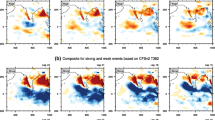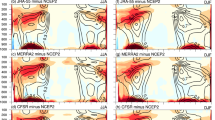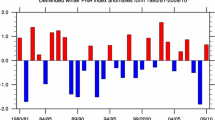Abstract
Since the interaction between atmospheric synoptic eddy (SE) (2–8 days) activity and low-frequency (LF) (monthly) flow (referred to as SELF) plays an essential role in generating and maintaining dominant climate modes, an evaluation of the performance of BCC_CSM1.1(m) in simulating the SE feedback onto the LF flow is given in this paper. The model captures well the major spatial features of climatological eddy vorticity forcing, eddy-induced growth rate, and patterns of SELF feedback for the climate modes with large magnitudes in cold seasons and small magnitudes in warm seasons for both the Northern and Southern Hemisphere. As in observations, the eddy-induced growth rate and SELF feedback patterns in the model also show positive SE feedback. Overall, the relationships between SE and LF flow show that BCC_CSM1.1(m) satisfactorily captures the basic features of positive SE feedback, which demonstrates the simulation skill of the model for LF variability. Specifically, such an evaluation can help to find model biases of BCC_CSM1.1(m) in simulating SE feedback, which will provide a reference for the model’s application.
摘 要
由于中高纬大气中天气尺度涡旋(2–8天尺度)与低频流(月尺度)的相互作用对于气候主模态的产生和维持起着重要的作用, 本文就 BCC_CSM1.1(m)模式中大气低频流与天气涡旋反馈的模拟能力进行了检验评估. 结果表明, 模式能够很好的抓住气候平均的涡旋涡度强迫, 涡旋增长率, 以及涡旋对大气主模态的动力反馈的空间特征. 气候平均的涡旋涡度强迫的量级在北半球和南半球均在冷季节大于暖季节. 模式中的涡旋增长率以及涡旋对大气低频主模态的反馈特征均表明涡旋反馈为正反馈作用, 这些结果与观测相一致. 总体来说, 天气尺度涡旋与大气低频流的关系显示 BCC_CSM1.1(m)模式能够抓住涡旋反馈的基本特征, 表明该模式对于低频变率具有一定的模拟技巧. 此外, 该评估工作可以找到模式模拟涡旋反馈的偏差, 这对于模式的应用具有重要的参考依据.
Similar content being viewed by others
References
Barnston, A. G., and R. E. Livezey, 1987: Classification, seasonality and persistence of low-frequency atmospheric circulation patterns. Mon. Wea. Rev., 115, 1083–1126.
Branstator, G., 1992: The maintenance of low-frequency atmospheric anomalies. J. Atmos. Sci., 49, 1924–1946, doi: 10.1175/1520-0469(1992)049<1924:TMOLFA>2.0.CO;2.
Branstator, G., 1995: Organization of storm track anomalies by recurring low-frequency circulation anomalies. J. Atmos. Sci., 52, 207–226, doi: 10.1175/1520-0469(1995)052<0207: OOSTAB>2.0.CO;2.
Cai, M., and M. Mak, 1990: Symbiotic relation between planetary and synoptic-scale waves. J. Atmos. Sci., 47, 2953–2968, doi: 10.1175/1520-0469(1990)047<2953:SRBPAS>2.0.CO;2.
Chang, E. K. M., 2006: An idealized nonlinear model of the Northern Hemisphere winter storm tracks. J. Atmos. Sci., 63, 1818–1839, doi: 10.1175/JAS3726.1.
Dee, D. P., and Coauthors, 2011: The ERA-Interim reanalysis: Configuration and performance of the data assimilation system. Quart. J. Roy. Meteor. Soc., 137, 553–597, doi: 10.1002/qj.828.
Duchon, C. E., 1979: Lanczos filtering in one and two dimensions. J. Appl. Meteor., 18, 1016–1022, doi: 10.1175/1520-0450(1979)018<1016:LFIOAT>2.0.CO;2.
Feldstein, S., 1998: The growth and decay of low-frequency anomalies in a GCM. J. Atmos. Sci., 55, 415–428, doi: 10.1175/1520-0469(1998)055<0415:TGADOL>2.0.CO;2.
Gong, D. Y., and S. W. Wang, 1999: Definition of Antarctic oscillation index. Geophys. Res. Lett., 26, 459–462, doi: 10.1029/1999GL900003.
Jiang, Z. H., J. Song, L. Li, W. L. Chen, Z. F. Wang, and J. Wang, 2012: Extreme climate events in China: IPCC–AR4 model evaluation and projection. Climatic Change, 110, 385–401, doi: 10.1007/s10584-011-0090-0.
Jin, F.-F., 2010: Eddy-induced instability for low-frequency variability. J. Atmos. Sci., 67, 1947–1964, doi: 10.1175/2009JAS 3185.1.
Jin, F.-F., L.-L. Pan, and M. Watanabe, 2006a: Dynamics of synoptic eddy and low-frequency flow interaction. Part I: A linear closure. J. Atmos. Sci., 63, 1677–1694, doi: 10.1175/JAS 3715.1.
Jin, F.-F., L.-L. Pan, and M. Watanabe, 2006b: Dynamics of synoptic eddy and low-frequency flow interaction. Part II: A theory for low-frequency modes. J. Atmos. Sci., 63, 1695–1708, doi: 10.1175/JAS3716.1.
Kang, I.-S., J.-S. Kug, M.-J. Lim, and D.-H. Choi, 2011: Impact of transient eddies on extratropical seasonal-mean predictability in DEMETER models. Climate Dyn., 37, 509–519, doi: 10.1007/s00382-010-0873-4.
Kok, C. J., J. D. Opsteegh, and H. M. van den Dool, 1987: Linear models: Useful tools to analyze GCM results. Mon. Wea. Rev., 115, 1996–2008, doi: 10.1175/1520-0493(1987)115 <1996:LMUTTA>2.0.CO;2.
Kug, J.-S., and F.-F. Jin, 2009: Left-hand rule for synoptic eddy feedback on low-frequency flow. Geophys. Res. Lett., 36, L05709, doi: 10.1029/2008GL036435.
Kug, J.-S., D.-H. Choi, F.-F. Jin, W.-T. Kwon, and H.-L. Ren, 2010c: Role of synoptic eddy feedback on polar climate responses to the anthropogenic forcing. Geophys. Res. Lett., 37, L14704, doi: 10.1029/2010GL043673.
Kug, J.-S., F.-F. Jin, J. Park, H.-L. Ren, and I.-S. Kang, 2010a: A general rule for synoptic-eddy feedback onto low-frequency flow. Climate Dyn., 35, 1011–1026, doi: 10.1007/s00382-009-0606-8.
Kug, J.-S., F.-F. Jin, and H.-L. Ren, 2010b: Role of synoptic eddies on low-frequency precipitation variation. J. Geophys. Res., 115, D19115, doi: 10.1029/2009JD013675.
Lau, N.-C., 1988: Variability of the observed midlatitude storm tracks in relation to low-frequency changes in the circulation pattern. J. Atmos. Sci., 45, 2718–2743, doi: 10.1175/1520-0469(1988)045<2718:VOTOMS>2.0.CO;2.
Lau, N.-C., and M. J. Nath, 1991: Variability of the baroclinic and barotropic transient eddy forcing associated with monthly changes in the midlatitude storm tracks. J. Atmos. Sci., 48, 2589–2613, doi: 10.1175/1520-0469(1991)048<2589: VOTBAB>2.0.CO;2.
Limpasuvan, V., and D. L. Hartmann, 1999: Eddies and the annular modes of climate variability. Geophys. Res. Lett., 26, 3133–3136, doi: 10.1029/1999GL010478.
Lorenz, D. J., and D. L. Hartmann, 2003: Eddy-zonal flow feedback in the Northern Hemisphere winter. J. Climate, 16, 1212–1227, doi: 10.1175/1520-0442(2003)16<1212: EFFITN>2.0.CO;2.
Luo, D. H., A. R. Lupo, and H. Wan, 2007: Dynamics of eddydriven low-frequency dipole modes. Part I: A simple model of North Atlantic Oscillations. J. Atmos. Sci., 64, 3–28, doi: 10.1175/JAS3818.1.
Nakamura, H., and J. M. Wallace, 1993: Synoptic behavior of baroclinic eddies during the blocking onset. Mon. Wea. Rev., 121, 1892–1903, doi: 10.1175/1520-0493(1993)121<1892: SBOBED>2.0.CO;2.
Nie, Y., Y. Zhang, X.-Q. Yang, and G. Chen, 2013: Baroclinic anomalies associated with the Southern Hemisphere Annular Mode: Roles of synoptic and low-frequency eddies. Geophys. Res. Lett., 40, 2361–2366, doi: 10.1002/grl.50396.
Pan, L.-L., F.-F. Jin, and M. Watanabe, 2006: Dynamics of synoptic eddy and low-frequency flow interaction. Part III: Baroclinic model results. J. Atmos. Sci., 63, 1709–1725, doi: 10.1175/JAS3717.1.
Ren, H.-L., F.-F. Jin, J.-S. Kug, J.-X. Zhao, and J. Park, 2009: A kinematic mechanism for positive feedback between synoptic eddies and NAO. Geophys. Res. Lett., 36, L11709, doi: 10.1029/2009GL037294.
Ren, H.-L., F.-F. Jin, J.-S. Kug, and L. Gao, 2011: Transformed eddy-PV flux and positive synoptic eddy feedback onto lowfrequency flow. Climate Dyn., 36, 2357–2370, doi: 10.1007/s00382-010-0913-0.
Ren, H.-L., F.-F. Jin, and L. Gao, 2012: Anatomy of synoptic Eddy-NAO interaction through eddy structure decomposition. J. Atmos. Sci., 69, 2171–2191, doi: 10.1175/JAS-D-11-069.1.
Ren, H.-L., F.-F. Jin, and J.-S. Kug, 2014: Eddy-induced growth rate of low-frequency variability and its mid-to late winter suppression in the northern hemisphere. J. Atmos. Sci., 71, 2281–2298, doi: 10.1175/JAS-D-13-0221.1.
Rivi`ere, G., and I. Orlanski, 2007: Characteristics of the Atlantic Storm-Track Eddy Activity and Its Relation with the North Atlantic Oscillation. J. Atmos. Sci., 64, 241–266, doi: 10.1175/JAS3850.1.
Robinson, W. A., 1991a: The dynamics of low-frequency variability in a simple model of the global atmosphere. J. Atmos. Sci., 48, 429–441, doi: 10.1175/1520-0469(1991)048<0429: TDOLFV>2.0.CO;2.
Robinson, W. A., 1991b: The dynamics of the zonal index in a simple model of the atmosphere. Tellus A, 43, 295–305, http://dx.doi.org/10.1034/j.1600-0870.1991.t01-4-00005.x.
Robinson, W. A., 2000: A baroclinic mechanism for the eddy feedback on the zonal index. J. Atmos. Sci., 57, 415–422, doi: 10.1175/1520-0469(2000)057<0415:ABMFTE>2.0.CO;2.
Schuenemann, K. C., and J. J. Cassano, 2009: Changes in synoptic weather patterns and Greenland precipitation in the 20th and 21st centuries: 1. Evaluation of late 20th century simulations from IPCC models. J. Geophys. Res., 114, D20113, doi: 10.1029/2009JD011705.
Tan, G.-R., H.-L. Ren, and H. S. Chen, 2015: Quantifying synoptic eddy feedback onto the low-frequency flow associated with anomalous temperature events in January over China. International Journal of Climatology, 35, 1976–1983, doi: 10.1002/joc.4135.
Tan, G.-R., F.-F. Jin, H.-L. Ren, and Z.-B. Sun, 2014: The role of eddy feedback in the excitation of the NAO. Meteorological Applications, 21, 768–776, doi: 10.1002/met.1415.
Thompson, D. W. J., and J. M. Wallace, 1998: The arctic oscillation signature in the wintertime geopotential height and temperature fields. Geophys. Res. Lett., 25, 1297–1300, doi: 10.1029/98GL00950.
Thompson, D. W. J., and J. M. Wallace, 2000: Annular modes in the extratropical circulation. Part I: Month-to-month variability. J. Climate, 13, 1000–1016, doi: 10.1175/1520-0442 (2000)013<1000:AMITEC>2.0.CO;2.
Vautard, R., B. Legras, and M. Déqué, 1988: On the source of midlatitude low-frequency variability. Part I: A statistical approach to persistence. J. Atmos. Sci., 45, 2811–2844, doi: 10.1175/1520-0469(1988)045<2811:OTSOML>2.0.CO;2.
Wallace, J. M., and D. S. Gutzler, 1981: Teleconnections in the geopotential height field during the Northern Hemisphere winter. Mon. Wea. Rev., 109, 784–812, doi: 10.1175/1520-0493(1981)109<0784:TITGHF>2.0.CO;2.
Wu, T. W., and Coauthors, 2010: The Beijing Climate Center atmospheric general circulation model: Description and its performance for the present-day climate. Climate Dyn., 34, 123–147, doi: 10.1007/s00382-008-0487-2.
Zhang, Y., X.-Q. Yang, Y. Nie, and G. Chen, 2012: Annular mode–like variation in a multilayer quasigeostrophic model. J. Atmos. Sci., 69, 2940–2958, doi: 10.1175/JAS-D-11-0214.1.
Zhou, T. J., Y. Q. Yu, H. L. Liu, W. Li, X. B. You, and G. Q. Zhou, 2007: Progress in the development and application of climate ocean models and ocean-atmosphere coupled models in China. Adv. Atmos. Sci., 24, 1109–1120, doi: 10.1007/s00376-007-1109-3.
Acknowledgements
This work was jointly supported by the National Science Foundation of China (Grant No. 41375062), the National Basic (973) Research Program of China (Grant No. 2015 CB453203), a China Meteorological Administration (CMA) Special Project (Grant No. GYHY201406022), and a CMA Key Project of Meteorological Prediction [Grant No. YBGJXM(2017)05].
Author information
Authors and Affiliations
Corresponding author
Rights and permissions
About this article
Cite this article
Zhou, F., Ren, HL. Dynamical feedback between synoptic eddy and low-frequency flow as simulated by BCC_CSM1.1(m). Adv. Atmos. Sci. 34, 1316–1332 (2017). https://doi.org/10.1007/s00376-017-6318-9
Received:
Revised:
Accepted:
Published:
Issue Date:
DOI: https://doi.org/10.1007/s00376-017-6318-9
Key words
- model evaluation
- synoptic eddy feedback simulation
- eddy vorticity forcing
- eddy-induced growth rate
- patterns of synoptic eddy feedback




